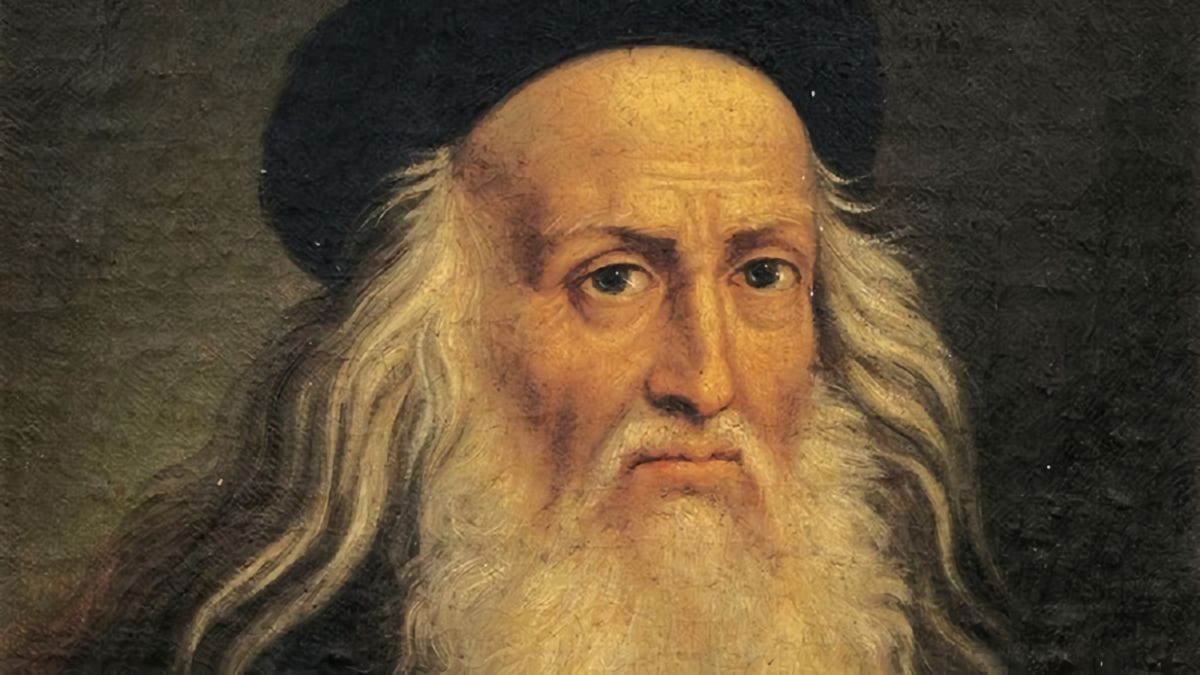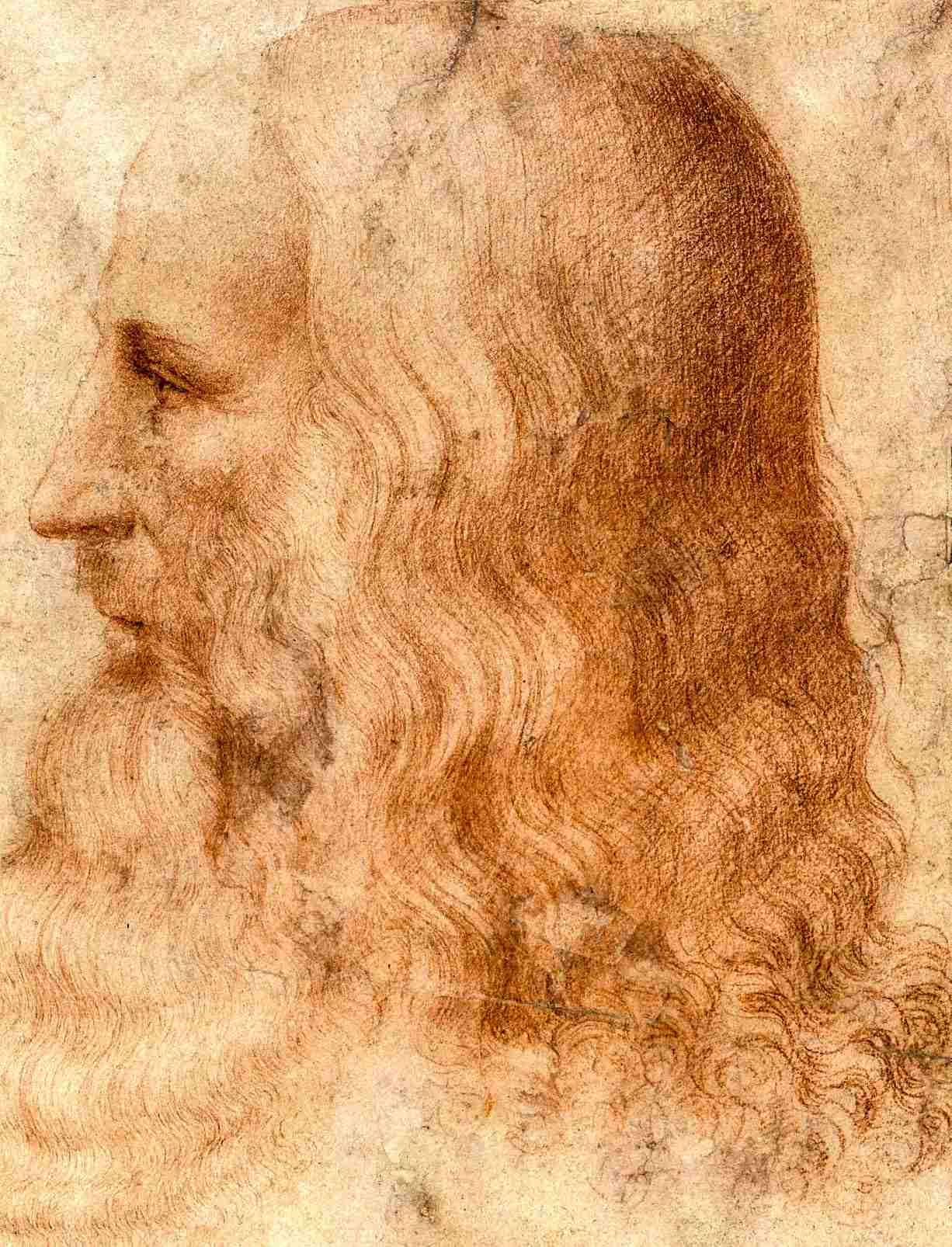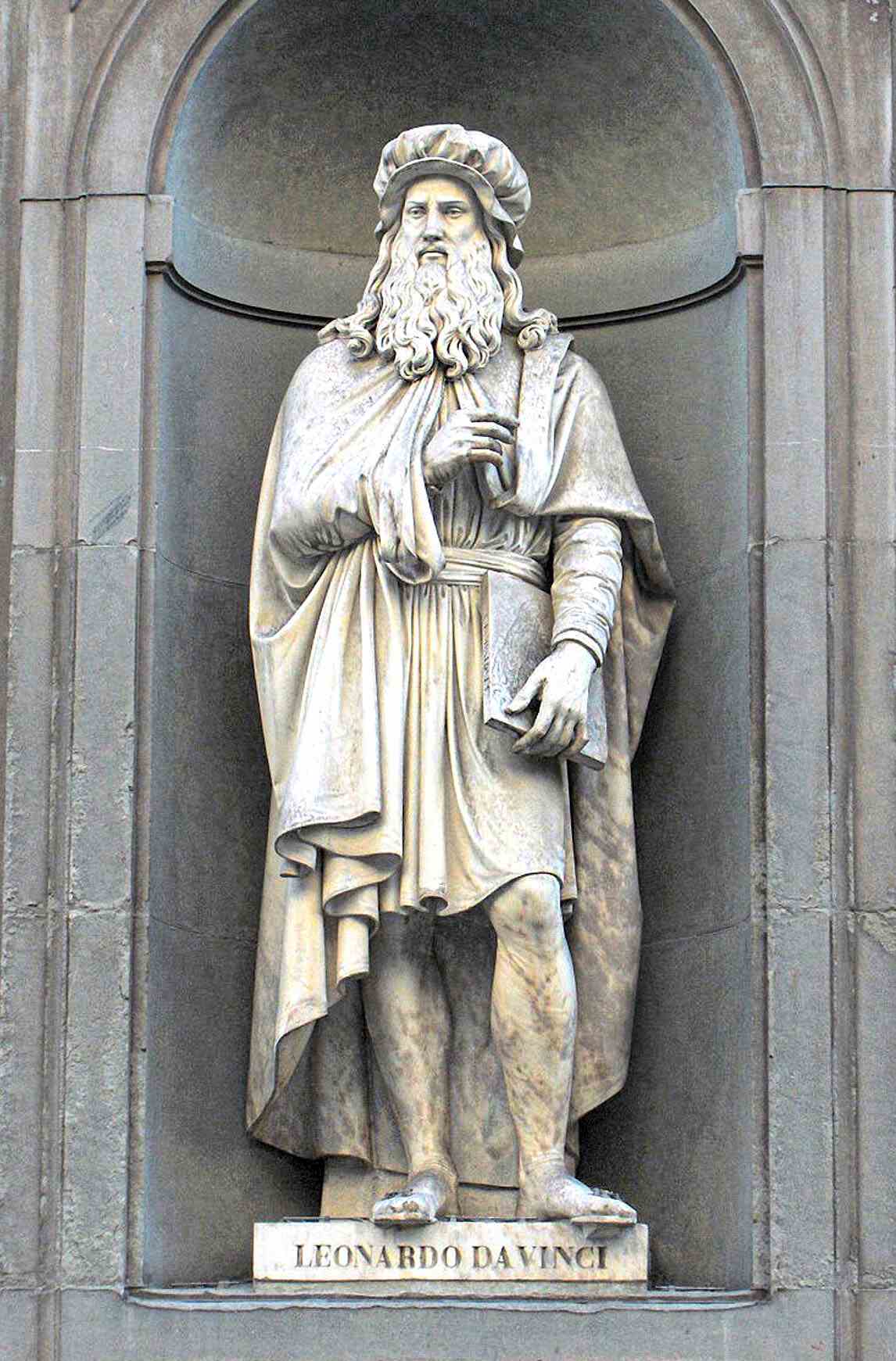Leonardo da Vinci was more than just a gifted painter. He was also a brilliant scientist, architect, engineer, astronomer, inventor, and an all-around genius. Despite his famous artistic creations like the Mona Lisa or the Last Supper, few of his scientific discoveries, apart from his notes, have been preserved for future generations. He designed self-propelled carts and aircraft, but he began to have these visions too early. Most of his innovative ideas and unfinished paintings remained in his notebooks, causing even this knowledgeable genius to feel like a failure.
- Learning the Ropes at the Feet of the Renaissance
- Art Becomes Science
- A Matter of Perspective
- Da Vinci’s anatomical studies
- Cars, bicycles, and perpetual motion
- Leonardo’s dream of flying
- A glimpse into Leonardo’s worldview
- How does the ebb and flow occur in the Mediterranean and Atlantic?
- The half-done genius
- A Renaissance intellectual
- Leonardo da Vinci’s designs
- His unfulfilled projects
- Leonardo da Vinci quotes
Around 500 years ago, on May 2, 1519, Leonardo di ser Piero da Vinci, one of the greatest polymaths in human history, passed away. In addition to creating unique works of art, he was also a scientific trailblazer. He envisioned ideal cityscapes, flying machines, “infinity machines,” a technique for measuring the distance between stars, and human anatomy. Many of his accomplishments remain remarkable and distinctive to this day.
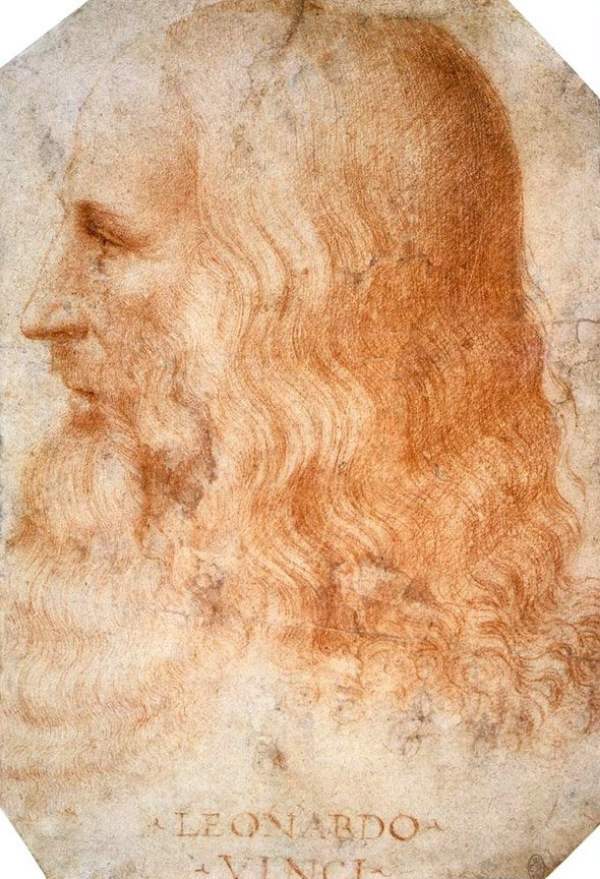
Nonetheless, his output reflects the labor of a brilliant mind that is still actively seeking new competitors today. Leonardo da Vinci, the quintessential Renaissance man, conceived utopian ideas that are still mystifying today.
Can one person really be so far ahead of their time? It’s difficult to comprehend how he could have foreseen concepts that would take centuries to be realized. The idea of using rotors to generate lift, which was originally conceived by da Vinci 500 years ago but was rediscovered and put into practice only a century ago with the introduction of diving ships.
In 1452, Leonardo da Vinci was born in the town of Anchiano in Tuscany (now Italy), not far from the town of Vinci from which he took his surname.
According to da Vinci himself, his art served as a means to an end: the pursuit of knowledge. “If you disdain painting, which is merely an imitator of all the works revealed by nature,” da Vinci declared, “you will surely disdain a precise investigation that examines all the textures of forms with philosophical and subtle speculation.” Da Vinci’s work elevated science above art, and the universe he imagined is still full of surprises.
Learning the Ropes at the Feet of the Renaissance
One Young Man’s Life in Tuscany
Anchiano, a little town close to Vinci, was his home for the first five years of his childhood. Today, the small town of Anchiano in northern Tuscany still retains its original appearance from the time when Leonardo da Vinci resided there.
It comprises a handful of farmhouses constructed from light-colored fieldstone, perched on a hill overlooking pine forests, olive orchards, and cypress forests, and surrounded by gently rolling fields. Da Vinci, the preeminent genius of his era, was born in this Italian town on April 15, 1452, around 3 a.m.
Da Vinci was born into the Renaissance, an era of change and rejuvenation. This epoch, during which intellectuals and artists revived the ideals of Greek and Roman antiquity, is often regarded by historians as marking the end of the “dark” Middle Ages.
In libraries, long-lost knowledge was rediscovered, sparking a renewed thirst for knowledge. Da Vinci would ultimately be celebrated as one of the greatest minds in human history.
Leonardo Da Vinci’s Family
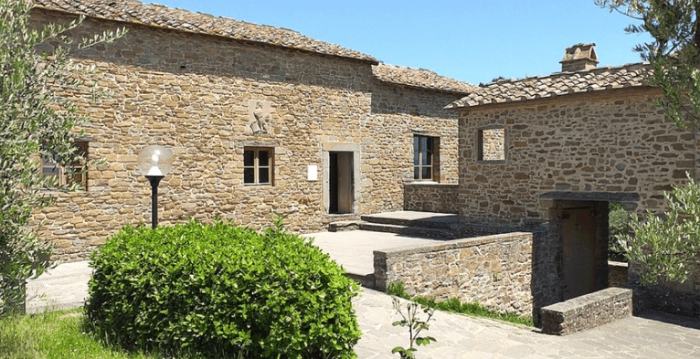
His mother was Caterina, a maid, and his father was Ser Piero da Vinci, a prominent notary from Florence. Leonardo was born into a tumultuous family at the time. While Ser Piero always acknowledged Leonardo as his son, he initially placed him in the care of a peasant family.
When Leonardo was five years old, Ser Piero moved in with his new wife, a 16-year-old-girl Albiera Amadori, whom he had previously married six months after Leonardo’s birth.
Ser Piero’s family resided in Vinci, and over time, Leonardo grew to consider Florence his “home,” even adopting the city’s name and referring to himself as “Leonardo the Florentine” but the name “Leonardo da Vinci stuck.”
Although he attended school sporadically for a few years, he gained enough literacy skills to read and write in this environment. It wasn’t until later in life that he fully grasped the four fundamental arithmetic operations.
Despite this, Leonardo was naturally curious and explored the countryside freely with his uncle Francesco or on his own, learning about the local flora and fauna, and investigating rivers, caves, and other hidden locations.
Having Trained with Master Verrocchio
Leonardo was unable to attend university due to his low social status. However, his father, Ser Piero, recognized his prodigious creative talent and arranged for him to apprentice with the Florentine master Andrea del Verrocchio.
While not a particularly innovative thinker, Verrocchio was a skilled artisan who worked in a variety of mediums, including jewelry, painting, sculpture, music, and woodcarving. He oversaw one of Florence’s most diverse workshops, and it was here that Leonardo began his artistic studies at the age of 14.
In keeping with the ethos of the emerging Renaissance, which harkened back to the traditions of antiquity and placed the creative human being at the center of knowledge, Leonardo developed a wide range of artistic abilities that reflected his restless and inquisitive temperament.
He painted, sketched, sculpted, cast, and worked in bronze. He also tailored clothing and helped plan magnificent feasts for the Tuscan courts.
After seeing the emotional depth of Leonardo’s art, Verrocchio recognized the limitations of his own abilities. When Leonardo painted an angel for Verrocchio’s piece “The Baptism of Christ” and the young apprentice’s work outshone his teacher’s, Verrocchio supposedly put down his brush forever. At least, that is what the folklore maintains.

Leonardo’s exceptional attention to detail is evident in his artistic pursuits, particularly in painting. This can be seen in almost all of his works of art, including his most famous piece, the “Mona Lisa.”
The painting not only captures the woman’s facial expression with groundbreaking precision but also the entire composition.
Countless intricate elements in the background of the painting are almost imperceptible due to Leonardo’s hazy “sfumato” technique.
Self-Sufficiency Dawns on Leonardo
At the age of 20, Leonardo was admitted to Florence’s the Guild of Saint Luke, a guild for painters. He had achieved master status and was now able to open his own shop and manage his own accounts.
Once he moved to Florence, he quickly befriended other painters such as Sandro Botticelli and Pietro Perugino and began networking with other creatives in the area.
He established his own studio in 1476, but he struggled to attract clients. The Medici family ignored him because he wasn’t interested in politics. When he was falsely accused of homosexuality and threatened with public ostracism and work restrictions, he decided to seek out a new patron.
Da Vinci wrote a “letter of application” to Ludovico Sforza, who would later become the Duke of Milan. In the letter, Leonardo highlighted his expertise in the production of military hardware, including his skills in constructing invincible chariots, bombards, mortars, missiles, and his expertise in ship defense and attack.
Although da Vinci briefly mentioned his other talents, like painting and sculpting, Sforza was confident that his inventions could meet all of the military’s requirements. As a result, Leonardo relocated from Florence to Milan in approximately 1482.
Art Becomes Science
Insightful Paintings
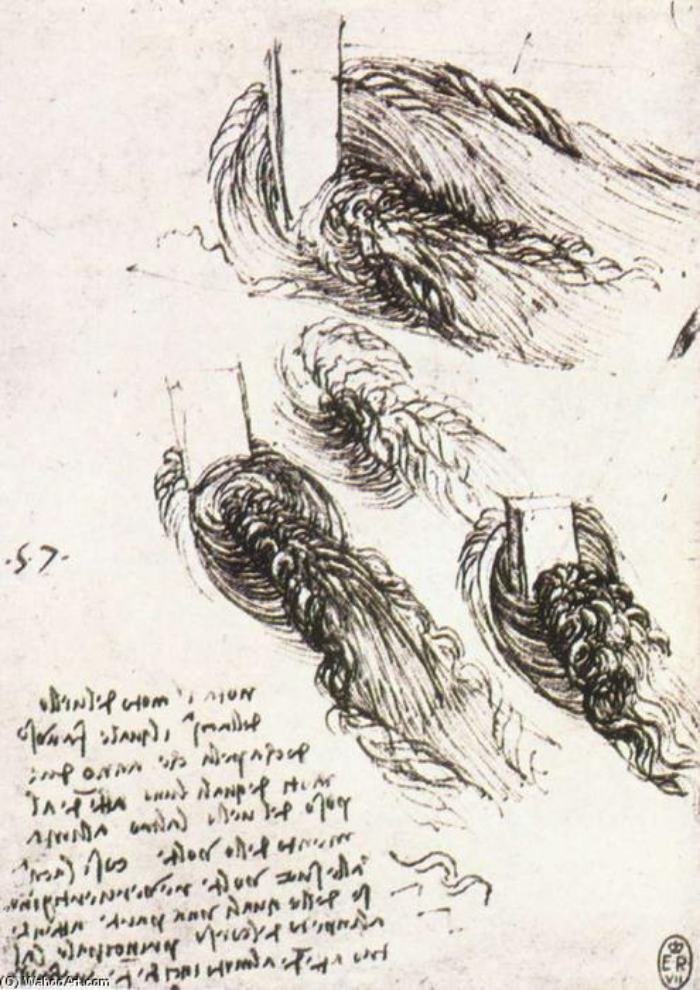
During his 20-year stay in Milan, Leonardo produced his most remarkable body of work. He managed to gain a foothold at the court of the Sforza family, the Milanese royalty.
Duke Ludovico Sforza, who was also known as “il Moro” or “the Dark One,” provided Leonardo with the opportunity to pursue his diverse interests beyond art by appointing him as a castle builder, military expert, and later, master of ceremonies.
Leonardo acquired knowledge in various fields such as geometry, statics, hydraulics, geology, optics, anatomy, zoology, botany, cartography, shipbuilding, and architecture.
In the city of Lombardy, Milan, Leonardo began documenting his ideas in notebooks, with meticulous attention to the visual presentation of his work, using mirror writing with his left hand.
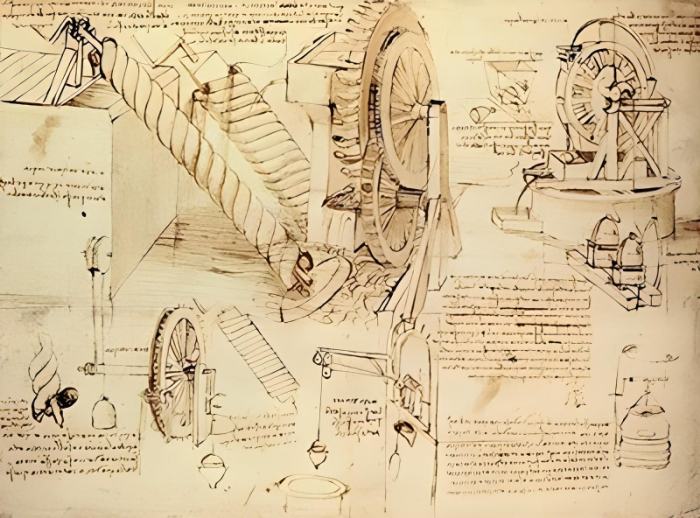
By the end of his life, the notebooks or codices, as they were called, had grown to almost 13,000 pages, with the breadth of knowledge comparable to a dictionary.
Although only around 7,000 pages have survived the centuries, they are still considered to be Leonardo da Vinci’s most significant contribution.
In terms of technology, Leonardo’s ideas found in his codices were centuries ahead of their time. He devised designs for everything from city layouts and hydraulic pumps to carts, machine guns, cranes, wheels, diving bells, and flying machines. For instance, Da Vinci’s diving suit was not only possible, but also practical.
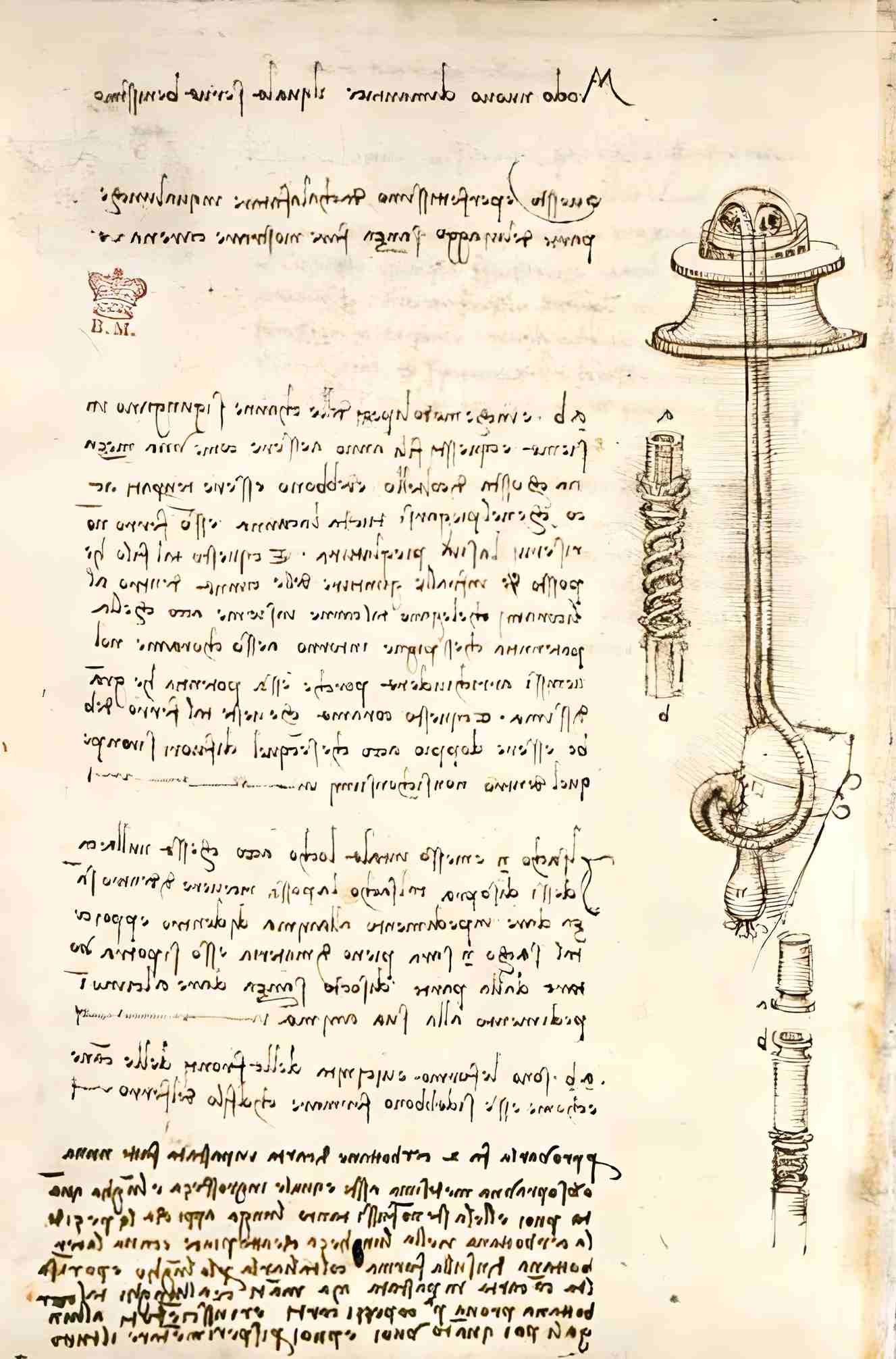
He also kept personal notes on the energy of nature and covered various topics such as the water cycle, continental drift, and human reproduction.
Alongside anatomical drawings, maps, and illustrations of fossils or plants, there were shopping lists, book recommendations, and philosophical discussions on the nature of science.
The codices contained guidelines for perspective drawing, advancements in foundry techniques, calculations, dates, instructions for hydraulic tests, and methods for measuring air pressure, gravity, and water flow, accompanied by images of fluid dynamics and traction.
For Leonardo, creation was a natural extension of his creative process. Painting was a means to an end, a tool he used to aid his understanding. To him, the two fields were interwoven. In one passage, he explored visual perception, focusing so intently on the “most critical instruments” that he delved into the anatomy of the eye.

From there, he delved into the mechanics of vision, debated the origins of light, and ultimately considered the stars, which served as a colossal mirror.
Next, he investigated water, studying its movements and drawing parallels between the waves on a lake, sound, and the sun’s rays. His experimentation with light and shadow in the darkroom ultimately brought da Vinci back to his painting pursuits.
Leonardo is a consummate observer, sketcher, and innovator. He sees himself as an analytical and critical thinker, capable not only of replicating but also improving upon the original. By skillfully documenting his ideas, Leonardo laid the foundation for contemporary observable and abstract scientific inquiry.
A Matter of Perspective
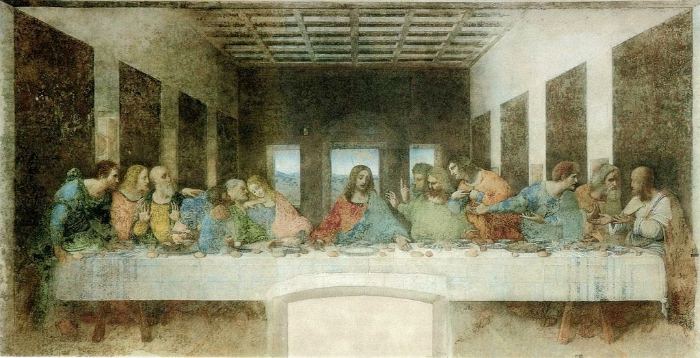
The number of paintings attributed to Leonardo da Vinci during his lifetime is approximately 30. However, it is his works of art, particularly the “Mona Lisa” and “The Last Supper,” that solidify his place in the history of art and make him one of the most renowned painters worldwide.
Even in his artistic creations, Leonardo’s analytical nature is apparent. He makes decisions regarding the painting’s composition, color scheme, and layout, while also considering lighting, placement of figures, and any shadow effects.
The early sketches of what is commonly regarded as his masterpiece, “The Last Supper,” can be found in geometrical treatises detailing how to construct an octagon from a circle.
An Important Task for the Monastery
The commission for “The Last Supper” came from Ludovico Sforza, who needed a painting to decorate the refectory, the dining hall for the monks at the Santa Maria delle Grazie monastery in Milan. In 1495, Leonardo began work on a fresco that would eventually measure approximately 30 feet (9 m) in length and over 13 feet (4 m) in height.
He envisioned the painting as an extension of the dining room, with Jesus and his followers seated at a table similar to the one used by the monks. He employed a dramatic perspective, which enhanced the sense of depth and complemented the refectory’s natural lighting.
Finally, he arranged the figures: All lines leading into the image converge at Jesus’ head, which serves as the painting’s vanishing point. By grouping each disciple in a trio, he departed from the conventional pattern of showing all 12 apostles on a single image plane.
Judas’ defensive posture as he fumbled with the bag containing the thirty pieces of silver was all the evidence Leonardo needed to portray him negatively, placing him in the shadow of Jesus’ preferred disciple, John.
Irregular Genius
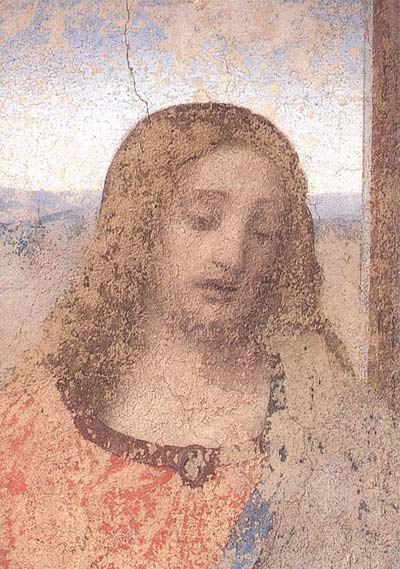
However, the “Last Supper,” which was supposed to lead to a revolution in pictorial composition, once again brought to light a trait of the universal genius that had already strained the patience of his clients several times. Because Leonardo was unreliable and infinitely slow.
Sforza, who commissioned the piece, had received complaints from the monks who lived there. For nearly a year, the monks had been waiting for da Vinci to finish their masterpiece, and all that was left was Judas’ head.
When questioned by the duke, Leonardo said that he actually spent at least two hours every day working on the project.
As the story goes, da Vinci spent almost a year frequenting a seedy doss house and rubbing elbows with the lowlife there, all for the sake of finding the perfect wicked visage to match Judas.
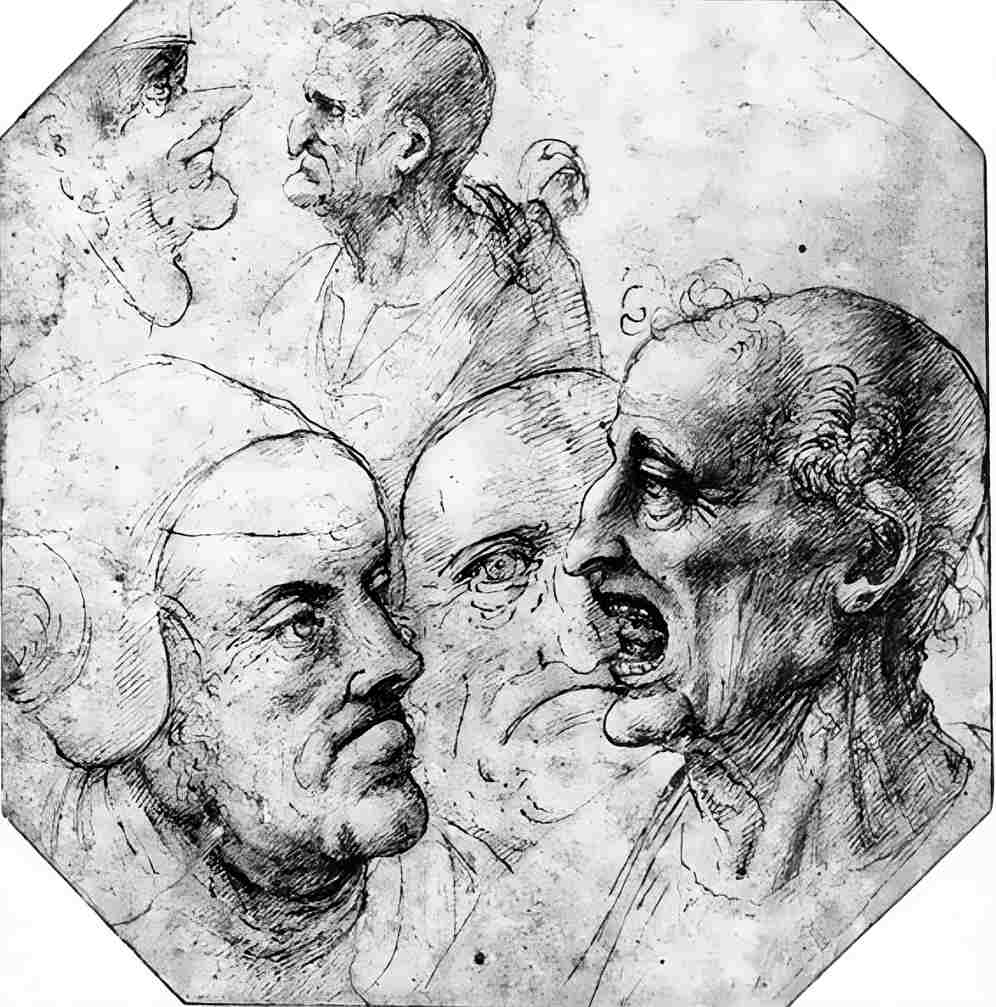
Leonardo placed a high value on physiognomic research, but his dedication to the field was exceptional for the period. He looked for face and hand models, classified noses into 10 different kinds from the side and 12 from the front and kept an eye out for body language and expressions of emotion.
But his inconsistency was problematic, as was the time he spent sketching and then painting his ideas. Leonardo was often sidetracked by anything that didn’t need his full attention. Ironically enough, his contemporaries were critical of his lack of interest in painting.
Instead of meeting deadlines, Leonardo often experimented with unusual methods, such as inflating sheep intestines into room size using bellows, giving tamed lizards wings created from the skin of other insects, creating lifelike wax dolls, or studying the many types of grapes in his vineyard.
When Leonardo Destroyed the Last Supper
During the Renaissance, artists used the quick fresco method, applying pigments to wet plaster for rapid execution before it dried, bonding the pigments as it cured. Skilled hands were needed to capture the image before the plaster dried too much to accept the pigments effectively. Leonardo da Vinci and other artists commonly employed this technique.
To destroy “The Last Supper,” all it took was one experiment: Leonardo’s meticulousness and high standards for perfection were incompatible with the quick fresco method of the time.
Painting “al fresco” involved working directly on wet plaster. A fast painter with good decision-making skills was essential for this technique. For the sake of saving time reworking his mistakes, Leonardo attempted the tempera on plaster technique and thus, came up with a new method.
However, this decision had terrible consequences. Paint began to peel and fell off in a continuous shower of flakes after just a few years. His Last Supper has been the subject of a conservation and restoration effort that has lasted generations.
Until it undergoes comprehensive repair, Leonardo’s “Last Supper” will remain a “maintenance case” for the foreseeable future.
Da Vinci’s anatomical studies
Neither the study of public figures nor the finger exercises for portraits satisfied Leonardo’s insatiable curiosity about the human form. For him, studying models was essential even in the late 15th century so that his depictions of people would often be anatomically accurate and convey the right emotions.
On the other hand, he went above and beyond when he was in his late 50s and back in Milan at the French governor of Milan Charles II d’Amboise’s request in 1506. The Council of Florence requested that Leonardo return quickly to complete The Battle of Anghiari, but the king of France, Louis XII, granted him permission to leave in order to commission portraits from him.
When it comes to human subjects, Leonardo was the first artist to ever do such an analysis. He dissected muscles and bones with the precision of a sculptor and the sight of a painter.
Dissected 35 cadavers in a year

In 1510, despite a papal prohibition, Leonardo dissected over 35 human cadavers by himself. At first, he was just curious about the body’s structure and mechanical processes, but as he dove further into his research, he grew more intrigued by physiological and medical concerns.
The small quantity of recently deceased corpses and their quick deterioration made the task more challenging. However, Leonardo was able to examine the bodies of people of all ages, and he quickly discovered significant disparities between them.
He dissected a dead man in Milan’s Santa Maria Novella Hospital in search of the elderly man’s cause of death. A “parchment-like, shrunken, and deformed artery” was the first example of arteriosclerosis to be described in medical literature, according to his findings.
After some time, Leonardo developed a genuine fascination with the inner workings of the human body, particularly the nervous system, cardiovascular system, digestive system, respiratory system, and musculoskeletal system.
The interdependencies of the body’s parts were of particular interest to him. By writing a dissertation titled “On the Structure of the Human Body,” he hoped to shed light on “the beginning of their being” for his fellow humans.
Leonardo usually carried a pen and pencil for just such an occasion. He dismantled the bodies carefully, protecting any vulnerable areas, and filling them with liquefied wax. He produced several drawings as a record of his study, attempted plastic portrayal from different vantage points, and experimented with different lighting conditions.
At odds with the antiquity

It was not always easy for Leonardo to put aside his conventional wisdom and put his whole faith in what he saw. While there was much that eluded him, he did his best to square his findings with the presumptions of antiquity and provide proof of their veracity, even if he could not explain it.
Da Vinci’s inaccurate depictions of the male and female reproductive systems included his belief that the penis was related to the testicles, lungs, and brain. Although sperm was essential for reproduction, a spiritual substance was also required. According to him, this material traveled down the spinal cord to the penis.
However, sometimes Leonardo was right. Though he never dissected a pregnant woman, Leonardo da Vinci was widely regarded as having created the first depiction of a human fetus in gestation. According to legend, he learned everything he knew about embryos from a pregnant cow.
But in the end, he also managed to debunk some of the traditional beliefs. Vitruvius (c. 80 BC–15 BC), a Roman architect, famously studied proportions and established the dimensions of a perfect body and Leonardo da Vinci drew inspiration for his Vitruvian Man from his ideas.
Leonardo took his own measurements to accurately record the stature of young men and to address flaws in Vitruvius’ antique model, such as the proportionally huge size of the feet.
Medically insignificant but artistically valuable

As far as we know, Leonardo’s anatomical book never saw the light of day. What he really wanted to do was explain what a soul was. Yet, the cardiovascular system, the respiratory system, and the vocal apparatus, the last of his research areas made him resignedly gave up on this pursue.
Awed by the intricacy of the universe, he had yet to solve the riddle of existence or make sense of the discoveries that he had made. His findings were pretty much useless according to the medical community of his time.
But what remains from his exploration of the human body are over 200 pages of drawings that possess remarkable scientific accuracy and artistic elegance, previously unseen by the world. His drawings were used as a kind of illustration for millennia before they were refined to become the gold standard of anatomical depiction.
Cars, bicycles, and perpetual motion
“Mechanics is the paradise of the mathematical sciences”
Leonardo was interested in the transfer of power his whole life. Specifically, he was thinking about how force could be multiplied and how back-and-forth motion could be converted into rotation.
Over the years, he came up with a great many innovations thanks to his fascination with weight, velocity, and leverage. As an engineer, Leonardo cared more about the usefulness of his inventions and how they might improve the lives of artisans than anything else.
In search of laws
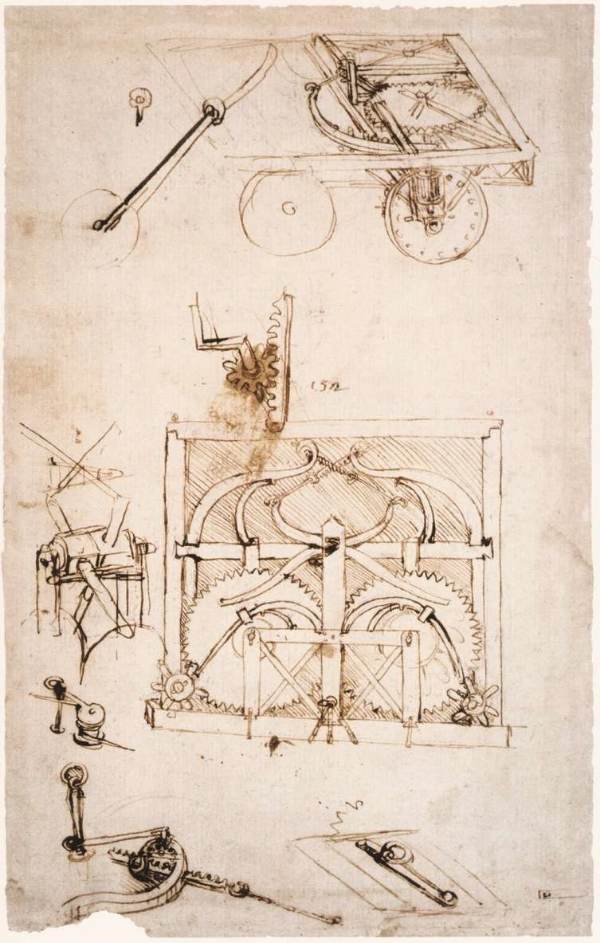
He investigated the possibility of universal physical rules and lays the groundwork for the parallelogram of forces, which won’t be fully defined until the 16th century. His findings included the dependence of friction on pressure and surface structure and the principles of leverage. Also, he created a lot of fundamental mechanical components.
Before developing the components for machines to handle complicated mechanical issues, he sketched screws, springs, pulleys, winches, and gears. Ball bearings, for example, were not devised for another 500 years; disc connections, which resembled modern clutches, were also included in his desings; as were intricate link chains, which he did not find any use.
He did not create the first gears, ratchets, levers, or pulleys, but he did discover some novel connections between them.
Almost there for the steam engine
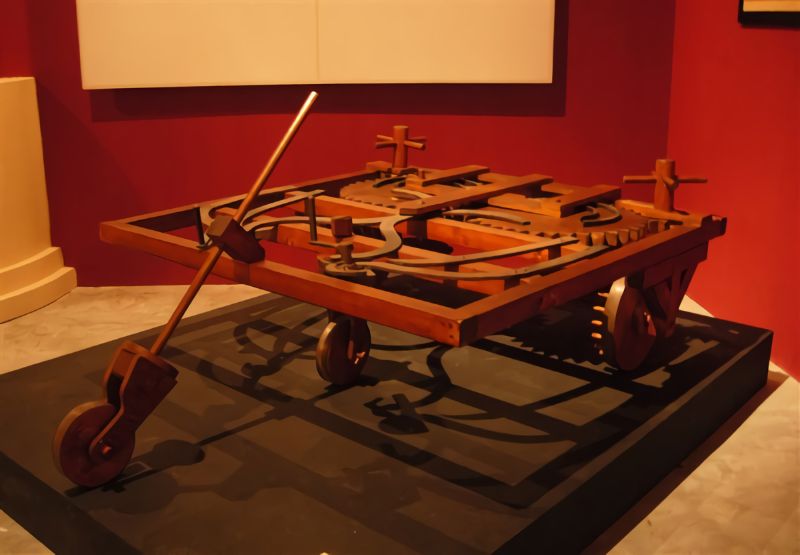
According to today’s specialists, Leonardo da Vinci was even on the edge of discovering steam power at the time, but the absence of energy sources was his largest obstacle in executing his innovations. With his theories, he foresaw industrial mass production by conserving labor and striving for enormous quantities.
His inventions included rolling mills, which used high-pressure cylinders to create metal sheets and foil. Via massive flywheels, he generated large compressive and tensile forces and then transmited that power using gears.
Machines such as drills and cranes, as well as cable winches, the screw machine, and automated printing presses, were all his inventions. Da Vinci anticipated making 60,000 ducats a year from a machine for sharpening needles using leather belts.
Muscle-powered cart
Da Vinci even designed a self-propelled cart. The gearbox was a set of springs, and the driver must continuously draw and release the springs to provide smooth driving action. Because da Vinci’s cart could only fit one person, the vehicle required a fair amount of physical strength and coordination.
Claims that Leonardo invented the bicycle have now been debunked. For a long time, the drawing of a rudimentary bicycle from the Codex Atlanticus (1478) was regarded as representing Leonardo’s flash of brilliance.
Unfortunately, modern research has shown that the sketch was really created in the 20th century and secretly inserted into da Vinci’s notebooks. A sufficient justification for the notion that Leonardo created the bicycle was that the drawing was included in the international printing of a biography of Leonardo in the 1970s without editorial assessment.
The alarm clock he created and used himself is one example of the strangeness of some of his creations. As water flew from one vessel to another, the filled vessel activated a lever through a gear train, causing Leonardo’s feet to be raised.
A fatal blow to the perpetual motion machine

Similarly, Leonardo considered the concept of perpetual motion. He hoped that a machine or device put in motion would continue to run indefinitely and conduct useful labor. Among Leonardo’s many suggestions was the “gravity wheel,” a device in which sheet metal chambers filled with mercury were meant to maintain the wheel’s indefinite spinning.
Another model wheel he created had balls rolling in grooves to provide asymmetrical torques, causing it to turn.
In the end, however, he used torque calculations to disprove perpetual motion and suggested that people seeking it instead become goldsmiths. For da Vinci, attempting to maintain constant power generation was like trying to create gold in a lab.
Leonardo’s dream of flying
Birds’ fluttering wings
Attempts at flight are now among Leonardo’s most impressive works. During Leonardo’s day, the idea of flying like a bird was not novel, but no one had come closer to making it a reality through their imagination than the brilliant inventor. Even in this area, Leonardo’s ideas were so far ahead of his time that the engineers wouldn’t catch on for another 400 years.
Concepts like aerostatics and aerodynamics were unfamiliar to Leonardo. His understanding of the phenomenon of lift in the air was rudimentary, primarily focused on his in-depth investigations into air resistance.
Birds and bats as role models
He meticulously examined each stage of the bird’s flight, recording them as slightly modified individual images on strips, akin to capturing frames with a movie camera. When assembled, these images seamlessly merged and animated the flight of the bird with a sense of graceful motion on the paper.
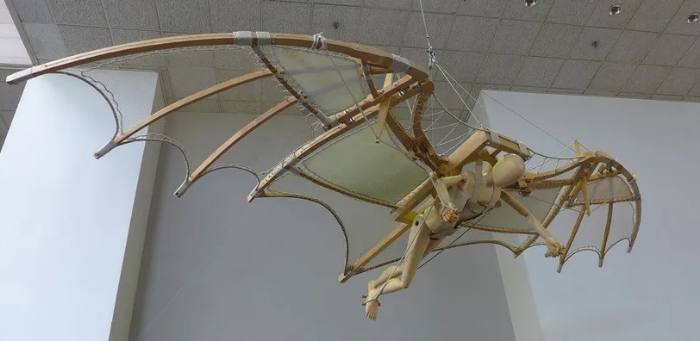
He devoted a quarter of a century to this task. For him, the mechanical wings were the essential component of a flying machine, and bats provided the best inspiration for da Vinci. He used ropes and levers to make his mechanical figures move and animate them, like marionettes. Using lever rods, he created a massive bat wing that a human could flap.
It wasn’t until 1505 that Leonardo began working on the actualization of a flying machine, following his still fairly analytical wing designs. The issue of propulsion, however, was largely overlooked by him. In his sketches, an “engine” was often nothing more than a block of undefined shape, and he rarely if ever addressed how it really worked. More specifically, he described the structure and workings of the flapping wings.
An absence of driving power
To tackle the issue of propelling power, Leonardo proposed having one or more daring pilots to push, pull, and crank with their arms and legs to put the colossal wings in motion.
He created the first retractable landing gear in aviation history, a structure of stilts 3.3 feet (1 m) high and a stairway by which the flying machine could be reached and carried onboard in order to take off, and a boat that could fly by rowing.
He turned to the science of aerodynamics after realizing that human muscular strength was inadequate for propulsion and that his contraptions would never fly. The scholar diligently examined the gliding of birds, the falling of leaves, and quantified the aerodynamic characteristics of the air.
Da Vinci designed the first aerometers to gauge air density, barometers to measure air pressure, and inclinometers to find the angle between an inclined and horizontal surface.
Parachute and helicopter
The invention of the parachute, a crucial tool in contemporary aviation, did not come until after da Vinci had given up on the dream of flying itself.
When duplicated today, Leonardo’s pyramidal parachute model proved to be effective. In essence, his “rotorcraft,” which consisted of a spiral constructed of two discs positioned above each other and cranked by two men, is already comparable to modern helicopters.
A glimpse into Leonardo’s worldview

In the early spring of 1504, Leonardo began drawing and designing the canal that would connect the Mediterranean to Florence through the Arno River. By exploring the Arno River plain, he hoped to locate more direct pathways for the river. Although da Vinci was always on the go due to the river-building project, he utilized his walks to reflect on fundamentals in geology, hydrology, and astronomy. After all, he had to learn about the waters before he could rule them.
The Codex Leicester, a booklet bound by Leonardo himself, is the product of his observations, drawings, and research on water. In all likelihood, he did not compose the 36 pages in chronological order, but instead sequenced them. In this notebook, Leonardo compiled his most seminal insights on the physical universe. Only this notebook of Leonardo’s remains in private hands today. In 1994, Bill Gates paid the approximate equivalent of 31 million US dollars to acquire it at auction.
Here are just a few examples of the kinds of questions addressed in the Codex Leicester, along with Leonardo’s insightful responses:
Does the earth have a water cycle?
“The waters are thus present beneath the floods within the veins, which originate from the depths of the sea and branch out within the body of the Earth, giving rise to the rivers. These rivers, in turn, continuously draw water from the depths and countless times have given the sea to the sea at the surface and taken the sea from the sea.”
According to Leonardo, the saltwater must travel down some kind of subterranean water vein to finally reach the mountainous regions. It then makes its way back to the ocean.
Why doesn’t the water cover the whole earth?
“Enclosed is the sea between the great valleys of the Earth, which serve as its vessel; and the edges of this vessel are the coastlines, and if they were to be removed, the sea would cover the entire Earth. However, since every part of the protruding land is higher than the highest height of the sea, the water cannot flow over them. Instead, it contentedly covers the areas of the Earth that form its basin.”
How do different stone shapes come about?
“When a river emerges from the mountains, it carries a great number of enormous stones in its bed. As it continues to flow, it carries smaller stones with worn corners, thus reducing the size of the larger stones. Further downstream, it has large pebbles followed by smaller ones, then coarse sand followed by fine sand, then coarse mud followed by fine mud, and so on. By the time it reaches the sea, its water is clouded with sand and mud. It deposits the sand along the shores of the sea, followed by the mud. However, it does not remain at the shoreline but, due to its lightness, it returns with the wave, and during calm periods, it sinks and remains on the seabed.”
Did rivers carve through the mountains?

“.. that they, with their meandering course, carried away the high plains enclosed by mountains, and that the mountains were sawed through can be recognized by the layers of rocks, which correspond to each other on both sides of the gorges created by the mentioned river channels.”
How were the Strait of Gibraltar and the Sinai Mountains formed?
“For a long time, the water of the Mediterranean Sea flowed into the Red Sea, eroding the flanks of the Sinai Mountains. This occurred due to the immense, rushing mass of water from numerous rivers that flowed into the Mediterranean, as well as the returning sea. And after, in the west, three thousand miles away from that place where the Calpe Mountain was cut through and separated from the Abile Mountain, the waters of the Mediterranean began to flow into the western ocean. As the water became shallower, the highest points emerged from the Red Sea, as the water had abandoned its course there.”
How do the Atlantic and Mediterranean Oceans experience high and low tides?
“Ebb and flow are not caused by the moon. This alternation of the sea increasing and decreasing every six hours can be caused by the stagnation of the waters that flow into this sea from the numerous rivers that flow into the Mediterranean Sea. The Mediterranean Sea, in turn, passes the water masses onto the ocean through the Strait of Gibraltar. As this ocean expands, it swells and stagnates in the many bays. And since this weight exceeds the force of the approaching water masses, the water again gains momentum in the opposite direction of its approach and mainly pushes against the Strait of Gibraltar, where this water is dammed for some time and also all the water that they have during this time remains and gets anew from the already mentioned rivers.”
How does the ebb and flow occur in the Mediterranean and Atlantic?
“The ebb and flow are not caused by the moon. This alternating pattern, where the sea rises and falls every six hours, can result from the accumulation of water brought into the sea by numerous rivers that flow into the Mediterranean. In turn, the Mediterranean transfers the water masses to the ocean through the Strait of Gibraltar. As the ocean expands, it swells in the many bays and becomes dammed. Since this weight exceeds the force of the approaching water masses, the water gains momentum in the opposite direction and pushes primarily against the Strait of Gibraltar. There, the water accumulates for a considerable time, including all the water it receives anew from the aforementioned rivers during this period.”
Why is the sky blue?
“I assert that the blue in which the air reveals itself is not its inherent color, but it originates from the warm moisture that evaporates into minuscule, imperceptible particles; these particles are struck by the sun’s rays and thereby illuminate themselves beneath the boundless darkness of the fiery realm, which, like a lid, envelops the air from the outside.”
Why does the moon shine?
“And if you were to believe that the moon has its own light, then you would be mistaken; and the light you see during its return in the middle of its cycle comes from the fact that it sees our Earth, which receives sunlight, and thus becomes full moon.”
How can the moon reflect light?
“Here it is shown that the Moon, which does not possess its own light, would neither be able to receive nor reflect the light it receives from the Sun back to us if it did not have a dense, shiny surface like the surfaces of mirrors and liquids.”
Naturally, Leonardo was mistaken in some points. Nevertheless, it is surprising how closely he often approached the truth – without a telescope, sediment collector, or other measuring device. Once again, his most magnificent tool was his mind, capable of drawing such conclusions.
The half-done genius
As a representative figure of the intellectual ferment of the 15th century, Leonardo da Vinci exemplified the Quattrocento. Despite facing many challenges and making many mistakes in his early adulthood, he did it with the enthusiasm of a young man. However, as he gets older, he will likely come to realize that he, too, is frequently wasting his time trying to uncover the world’s hidden mysteries and turn them into something of practical benefit to humanity.
Despite spending 20 years at the Sforza Court in Milan, Leonardo never again felt at home. Around 1500, he made his way out of town and continued traveling. He becomes a combat engineer for Cesare Borgia’s army. He spends some time in Florence, but eventually comes back to Milan to work for the French as their royal painter and engineer.
His time with Pope Leo X in Rome lasts for three years. The French King Francis I picks him up after he is abandoned by both men. The royal property of Cloux, not far from the King’s seat in Amboise, is where Leonardo settles in France after being appointed as the King’s architect.
Here, Leonardo spends his twilight years. He has given up painting but is still working on important issues. His final goal was to open up navigation on the Loire River and its tributaries. Leonardo da Vinci had a stroke on May 2, 1519, and passed on the next day. His ideas never materialized.
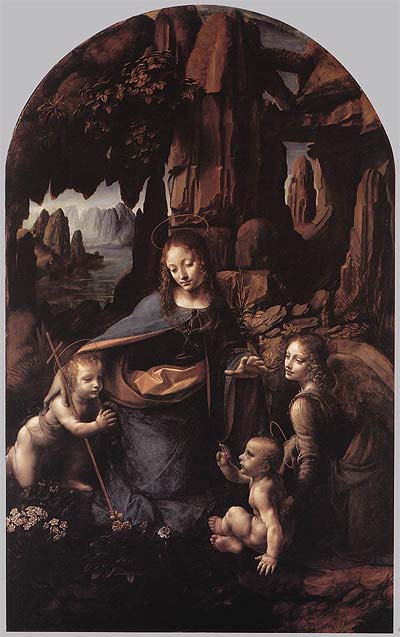
Like many of Leonardo’s beliefs, trying to understand him is probably bound to fail. An outsider’s impression of this man and his utopias is unsettling. Knowledge from the future, as if gathered by a time traveler, frequently overwhelmed his fellow humans. However, it’s impossible not to shake your head in awe at the breadth and depth of his discoveries, inventions, and foolish mistakes.
The barometer, gliders, machine guns, and mechanical alarm clocks were all his creations. It’s unclear, though, how many of his ideas were never put into action. What happened to the forts he envisioned and the bridges he drew up? Where are the canals he envisioned, and who operated his spinning mills, drills, mills, and excavators? When did he first attempt to fly? Unfortunately, almost none of Leonardo’s ideas ever made it beyond his notebooks or weren’t rediscovered until decades later.
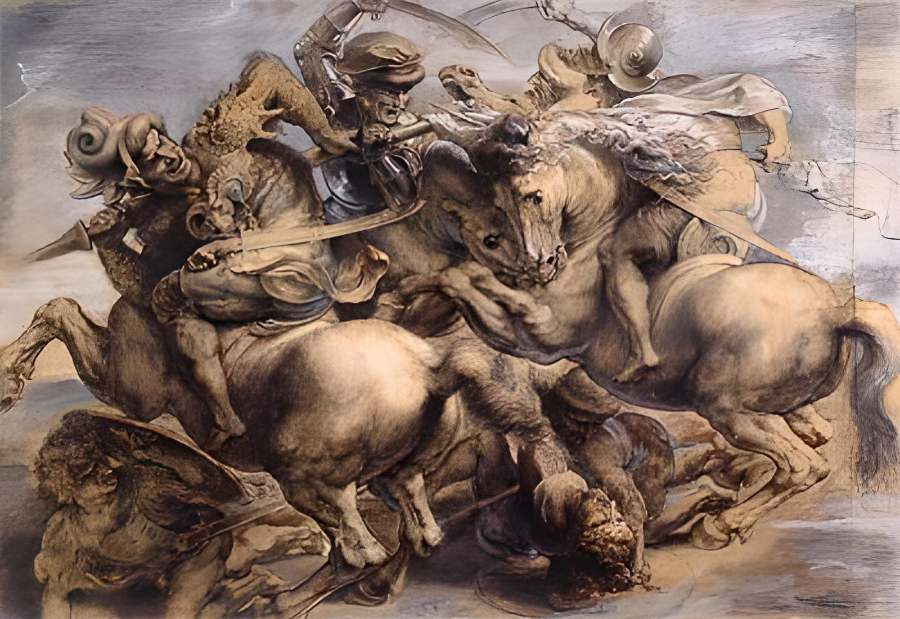
The “Mona Lisa,” “The Last Supper,” “The Madonna of the Rocks,” “St. John the Baptist,” and “Anna Selbdritt” are just a few of the masterpieces that Leonardo left behind. Though he started numerous paintings, he never managed to complete them all. He spent nearly a decade on the unfinished “Leda with the Swan” artwork. The city councils of Florence were his paying customers, and he owed them the “Battle of Anghiari.” Though he received several commissions, Leonardo only completed a handful of paintings. In addition, the bronze he had set aside for a gigantic equestrian statue of Francesco Sforza, whose design had gotten him into the Milanese court, was instead used to make cannons, dooming his longest and most laborious sculpture project.
Art historians and critics argue that Leonardo’s indecisiveness contributed to the global genius’ unfinished works. But in the end, it was the outcome of his desire to make something flawless.
Even though many of his inventions were feasible and might have been lucrative, Leonardo frequently settled for only hammering out a concept. For him, the pursuit of a problem ended when he discovered its resolution. After he had a rough outline of the evidence and explanation written down, he seldom returned to the same question unless it was necessary to address a different issue.
In actuality, he was probably much ahead of his time. The majority of his plans were never even fully comprehended. Perhaps, though, it is exactly in this imperfection that the charm of his legacy rests.
A Renaissance intellectual
The name Leonardo da Vinci is almost synonymous with the word genius. He was a genius, but his influence on history was largely limited to the development of the field of art. His scientific research saw interest from a limited number of people at the time, and most of his discoveries never materialized.
Leonardo da Vinci was a typical Renaissance intellectual. It had a great influence on the development of painting, pattern making, and sculpture. In addition to being an innovator in terms of reflecting light and shadow in the picture using new materials and composition, he was also a pioneer in the fields of drawing and perspective of the human anatomy. Leonardo was also a great scientist, engineer, and inventor, as we learned from his diaries that were published a long time after he died.

Leonardo da Vinci was born in the town of Vinci, in the Tuscany region of Italy. His father was a notary, and his mother was a peasant. At the age of 16, he started working as an apprentice in Florence, in the workshop of the painter Andrea del Verrocchio. Here, his abilities were evident. He was considered a master at the age of 20 and worked in Florence and Milan, where he made some religious paintings such as The Adoration of the Kings, Virgin of the Rocks, and The Last Supper.
This self-portrait made by Leonardo da Vinci around 1510 had an important place in his life. The artist owed his extraordinary drafting talent to his anatomy studies. He kept detailed notebooks on anatomy during his lifetime, especially while in Milan. These notebooks, containing the artist’s observations, thoughts, drafts, and inventions, were about 13,000 pages. Only 5,000 of these have survived to the present day.
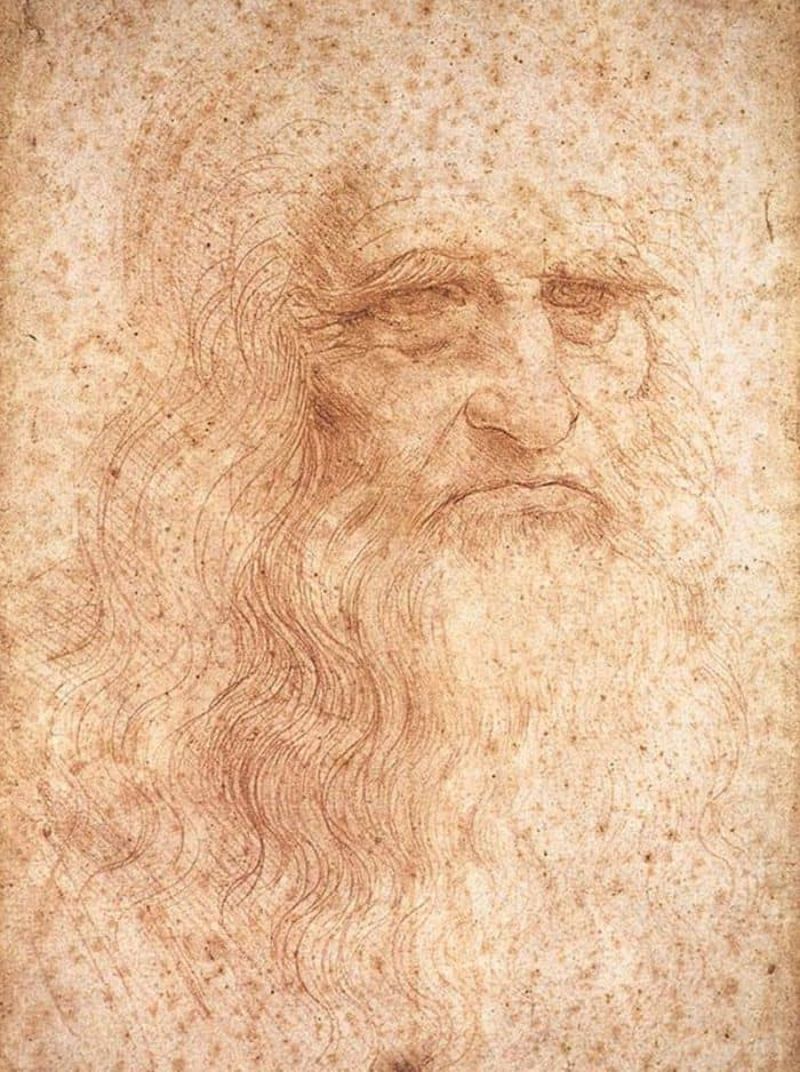
Filled with careful analysis, skepticism, and experience, these notebooks show that Leonardo da Vinci embraced the scientific method much earlier than Galileo Galilei and Isaac Newton. Leonardo was far ahead of his time when he grasped the fields of optics, earth science, hydrodynamics, and astronomy, as well as the principles behind gears, levers, consoles, power, and motion.
Leonardo da Vinci’s designs
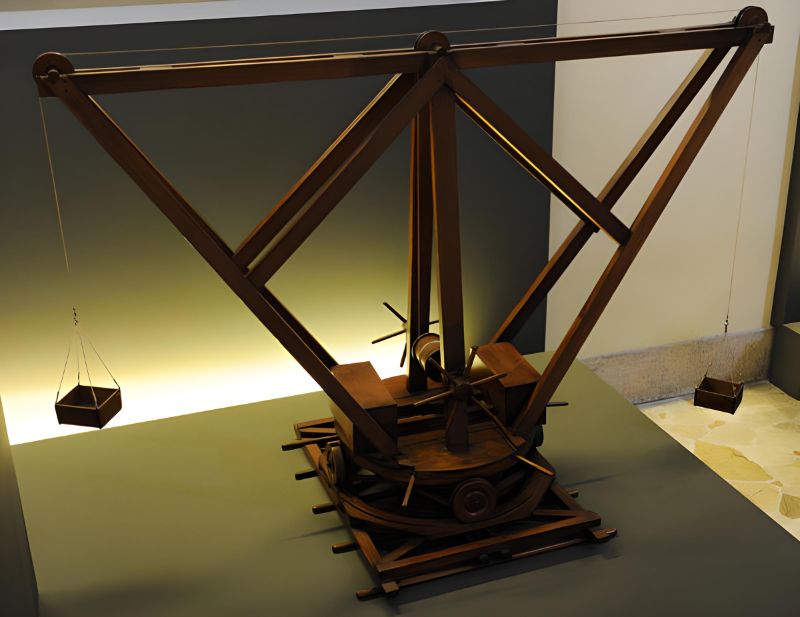
Leonardo da Vinci’s twin cranes were designed for use in quarries. The stones cut from the rock surface get put in one bucket, and when the crane makes a full turn, the other one is filled and the first one gets empty.
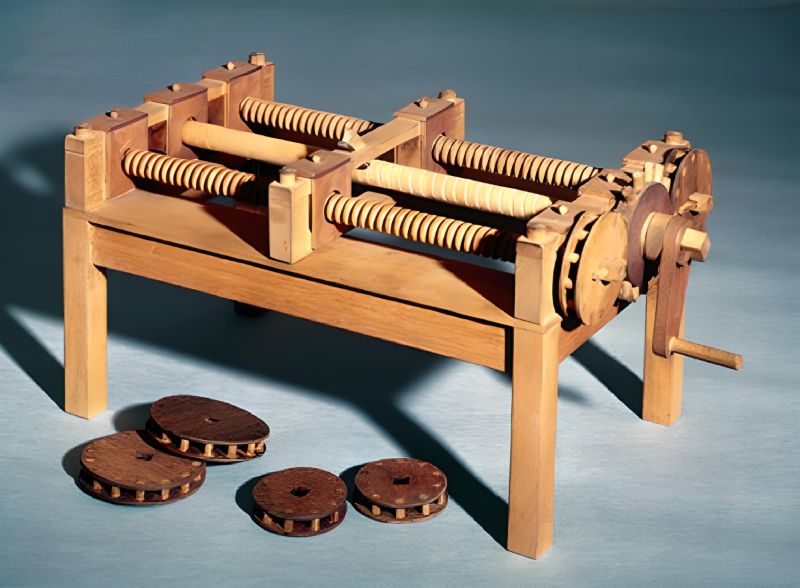
This model is made according to Leonardo da Vinci’s grooving machine drawing. When the crank arm is turned, the central dowel starts to rotate. With the rotation of the augers on both sides, the cutting tool moves along the central wooden dowel.
His unfulfilled projects
Between 1485 and 1499, when Leonardo da Vinci worked as an engineer and military architect for the two dukes of Milan, and later provided similar services for other patrons, such as the famous Cesare Borgia (1475–1507), he found the opportunity to apply some of his theoretical drawings and studies. In reality, Leonardo was promising extraordinary engineering projects while offering his services to these people, and he was only mildly talking about his skills in painting.
Among Leonardo’s notebooks are detailed sketches of many surprising discoveries. Certainly, most of them have never been implemented. These drafts include a giant crossbow, various flight machines, a helicopter, a human-like mechanical robot, a diving device, a bicycle, and an alarm clock powered by water power.
Since the 19th century, there has been a great interest in Leonardo da Vinci both in academic circles and in the public. In the past few years, some of his discoveries on paper have finally become realities. Leonardo da Vinci’s drawings were surprisingly applicable, although in some cases, they required minor adaptations.
Only a few of Leonardo da Vinci’s inventions were able to leave the paper and enter human use during his lifetime. However, since there was no patent application in Italy at that time, there were few exact records of how and when the inventions could be used in real life. Two known examples are a coil winding machine and a mirror grinding machine. No matter how useful they are, these tools fail to show Leonardo da Vinci’s extraordinary genius and foresight.

The artist had envisaged that this vehicle would move like a watch, using a spring. There is no place for the driver. Because the vehicle was designed to go on its own. Like most of Leonardo’s important discoveries, this machine was not produced during the artist’s lifetime.
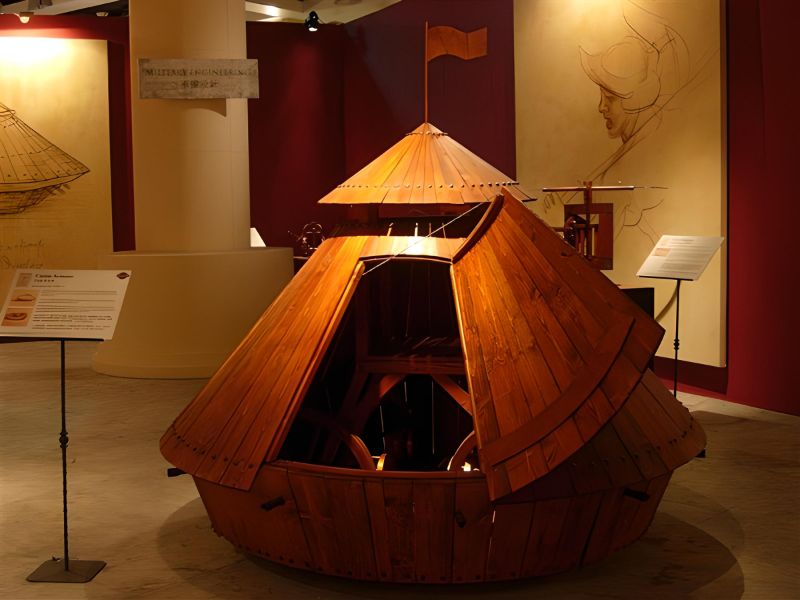
This model, made by IBM, was exhibited at the Clos Luce Castle in France, the artist’s last home. The top of the tank, which was moved by turning the arms, was reinforced with perforated metal plates. Thus, the soldiers inside the vehicle could fire outside.
In 1513, Leonardo da Vinci met François I, King of France, who took over Milan. The king asked Leonardo to build a lion-shaped vending machine. Leonardo made a lion that turns his head and even offers a bunch of orchids when properly cared for. The king was so impressed by this invention that he became the protector of Leonardo, and the artist spent the last three years of his life in Amboise, France. Leonardo da Vinci, who is better known for his amazing drawing skills than for his knowledge of science and amazing discoveries, died here in peace.
Leonardo da Vinci quotes
“Learning never exhausts the mind.”
“Simplicity is the ultimate sophistication.”
“Time stays long enough for anyone who will use it.”
“I love those who can smile in trouble, who can gather strength from distress, and grow brave by reflection. ‘Tis the business of little minds to shrink, but they whose heart is firm, and whose conscience approves their conduct, will pursue their principles unto death.”
“Poor is the pupil who does not surpass his master.”
“It had long since come to my attention that people of accomplishment rarely sat back and let things happen to them. They went out and happened to things.”
“I have been impressed with the urgency of doing. Knowing is not enough; we must apply. Being willing is not enough; we must do.”
“The noblest pleasure is the joy of understanding.”
“Experience never errs; it is only your judgments that err by promising themselves effects such as are not caused by your experiments.”
“All our knowledge has its origins in our perceptions.”
“Although nature commences with reason and ends in experience, it is necessary for us to do the opposite, that is to commence with experience and from this to proceed to investigate the reason.”
“There are four powers: memory and intellect, desire and covetousness. The two first are mental and the others sensual. The three senses sight, hearing, and smell cannot well be prevented; touch and taste not at all.”
“Just as food eaten without appetite is a tedious nourishment, so does study without zeal damage the memory by not assimilating what it absorbs.”
“All knowledge which ends in words will die as quickly as it came to life, with the exception of the written word: which is its mechanical part.”
“The truth of things is the chief nutriment of superior intellects.”
“Life well spent is long.”
“Common sense is that which judges the things given to it by other senses.”
“Knowledge of the past and of the places of the earth is the ornament and food of the mind of man.”
“As a well-spent day brings happy sleep, so a life well spent brings happy death.”
“Men of lofty genius when they are doing the least work are most active.”


